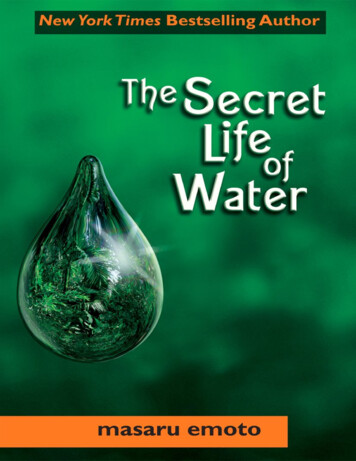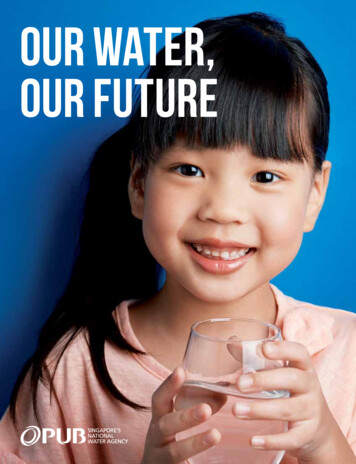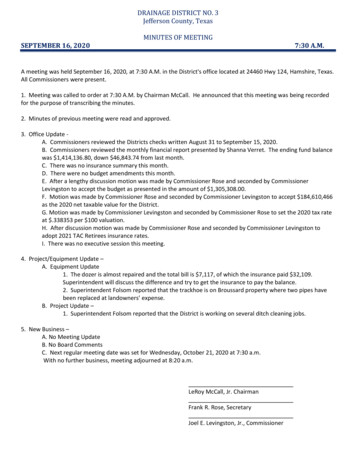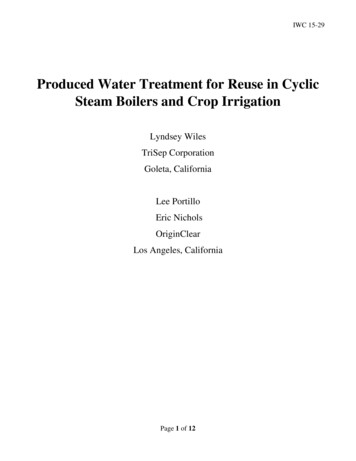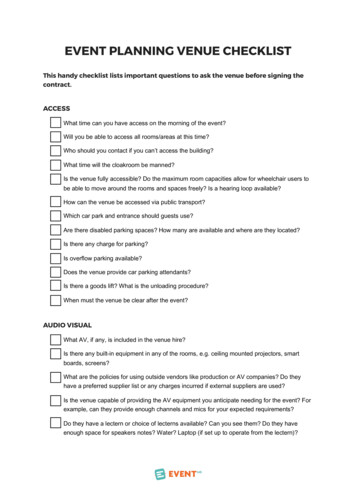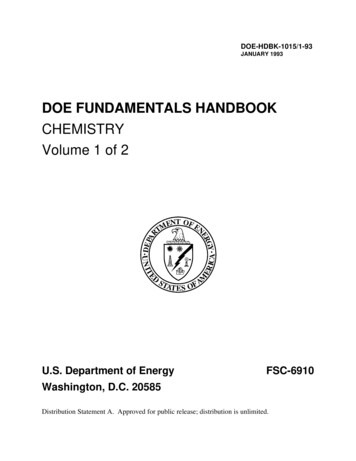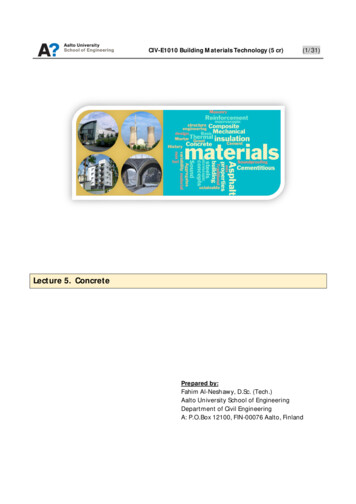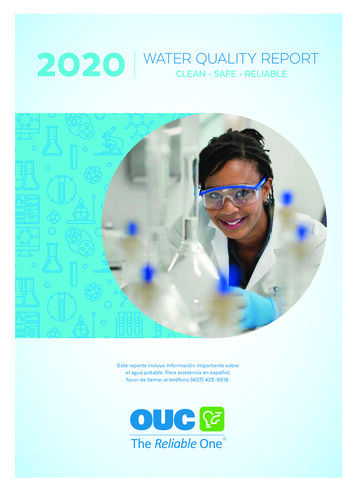
Transcription
2020WATER QUALITY REPORTCLEAN SAFE RELIABLEEste reporte incluye información importante sobreel agua potable. Para asistencia en español,favor de llamar al teléfono (407) 423-9018.Water Quality Report 2020 6x8-5.indd 14/23/21 9:52 AM
A WORD FROM OURGENERAL MANAGER & CEOAt OUC — The Reliable One, there is no greater priority than the safety ofour customers, employees and community. We take our responsibility andcommitment to providing clean, safe, great-tasting water every second ofevery day very seriously.This 2020 OUC Water Quality Report affirms this commitment, backing it upwith a compilation of test results and other important information about thequality of the water you drink and our efforts to conserve it.The source of your drinking water is the Lower Floridan aquifer, a well-protected reservoir located hundredsof feet below ground. OUC treats this high-quality water with ozone, the strongest disinfectant available.Additionally, our state-certified water lab conducts thousands of chemical and bacteriological water-qualitytests throughout each year, including tests for more than 135 regulated and unregulated substances likelead and copper. Summaries of those results are included in this report.Water is a limited resource, and we all can work together to ensure it is available for future generations.With that in mind, OUC partners with the Orlando Science Center on an educational initiative in local publicschools. Since 2006, more than 94,000 elementary, middle and high school students have participated in ouraward-winning Project AWESOME (Alternative Water & Energy Supply, Observation, Methods and Education)and the Water Color Project. We also partner with the St. Johns River Water Management District to educateour customers and the community on what can be done to reduce water consumption, especially duringtimes of low rainfall and drought. Additionally, OUC offers free conservation audits and rebates to help homeand business owners with the costs of water efficiency upgrades. And significant investments in innovativetechnologies, like smart water meters and leak detection monitoring, allow us to proactively identify areas forimprovement regarding both customer consumption and our water infrastructure.I hope the 2020 Water Quality Report reassures you that we take our responsibility of protecting andpreserving the public’s water supply very seriously. If you have any questions or concerns about waterquality or conservation, please don’t hesitate to contact OUC’s Water Quality Lab at 407-434-2549.ABOUT OUC—THE RELIABLE ONE— Clint BullockOUC General Manager & CEOOUC is a municipal utility owned by the citizens ofOrlando and governed by a board of commissioners.As the second largest municipal utility in Florida and14th largest municipal in the country, OUC provideselectric, water, chilled water and/or lighting services to400,000 customer accounts in Orlando, St. Cloud andparts of unincorporated Orange and Osceola counties.OUC is one of the largest water utilities in the stateand serves a population of approximately 451,000.2 Water Quality Report 2020Water Quality Report 2020 6x8-5.indd 24/23/21 9:52 AM
SAFE, RELIABLE DRINKING WATERFOR GENERATIONS TO COMEA NATURALLY CLEAN WATER SOURCEOUC’s water comes from the Lower Floridan aquifer,an underground reservoir that, in many places, isa quarter-mile below parts of the Earth’s surface.The aquifer is fed by rainwater that goes through afiltration process as it seeps through hundreds of feetof sand and rock. OUC pumps water from the aquiferto facilities where it’s treated to meet standards thatensure the water is safe to drink.PROMOTING WATER CONSERVATIONOUC works year-round to educate the communityabout the importance of protecting such a precious— and limited — natural resource. From waterconservation themed events, campaigns and studentprojects to proactive traditional and social mediaoutreach during times of low rainfall or drought, weare committed to helping our customers understandthe vital role water plays in everyday life and howcrucial their role is in protecting it.OUC also offers services that help customersbecome water-wise consumers. Our conservationteam conducts home audits to search for potentialsources of water loss and make recommendationson improvements. Some recommended upgradesare eligible for OUC rebates, including low-volumeirrigation systems, ultra-low-flow toilets, and watercisterns. Customers also have online access to waterconservation tips and videos covering such topicsas leak detection, water-wise landscaping, faucetaerators, and more. For additional information,visit OUC.com/water.OZONE PROCESS PRODUCESGREAT-TASTING TAP WATEROUC uses ozone treatment at our seven water-serviceplants as part of a process to produce high-quality,great-tasting tap water we call H2OUC. Ozone oxidizeshydrogen sulfide to improve taste, eliminate odor andreduce the amount of chlorine that’s added to water.By law, we are required to add chlorine to our waterto maintain its high quality as it flows through pipesto customers’ taps. Fluoride also is added to promotehealthy teeth, and we add sodium hydroxide to adjustthe pH, preventing copper and lead from leachinginto the drinking water from customers’ plumbing,the primary source of these elements.PROTECTING OUR WATER FACILITIESBecause the safety of your water is of the utmostimportance, OUC goes to great lengths to keep ourwater treatment facilities secure. All OUC water plantsare equipped with state-of-the-art security, includingintrusion-detection systems, alarms, cameras andfences around the perimeter of properties. Armedsecurity guards and law enforcement officersregularly patrol the facilities.Water Quality Report 2020Water Quality Report 2020 6x8-5.indd 334/23/21 9:52 AM
MAKING WATER CONSERVATIONA FUN LEARNING EXPERIENCEThrough water-conservation-themed classroomprograms, OUC is teaching public school studentsabout the importance of preserving and protectingFlorida’s water supply. Since 2006, more than94,000 local students have participated in OUC’sWater Color Project and Project AWESOME(Alternative Water & Energy Supply, Observation,Methods and Education). The Water Color Projectencourages Orange County students to use theirartistic talents to promote conservation. Fourthand fifth-graders compete to have their artworkfeatured in OUC’s annual Water ConservationCalendar while middle and high school studentspaint water-themed rain barrels for judging.Project AWESOME delivers an interactive lab to fifthgraders in Orange and Osceola counties. Studentsmake an aquifer, build solar-powered cars andvalidate the efficiency of low-flow showerheadsand compact fluorescent light bulbs (CFLs).OUC’s efforts to spread the word on waterconservation go beyond the classroom. Everyonecan help save water by following a few simple tips: Water your lawn before 10 a.m. or after 4 p.m.to minimize the amount lost to evaporation. Water just once a week in cooler months andtwice a week in warmer months. Water your lawn for just 30–45 minutesper session. Repair leaking faucets and toilets. Install water-saver shower heads andtake shorter showers.For more ways to save water, visitwww.ouc.com/waterconservation.As part of OUC’s Water ColorProject, elementary schoolstudents created the artwork(below), which is featured inthe 2021 Water ConservationCalendar. Local middle andhigh school students paintedthe rain barrels (right).4 Water Quality Report 2020Water Quality Report 2020 6x8-5.indd 44/23/21 9:52 AM
WHERE DOES YOURWATER COME FROM?Well pumps at OUC’s watertreatment plants draw water from anatural underground reservoir calledthe Lower Floridan aquifer. Afterbeing sent through ozone contactbasins, the water is treated withchlorine and fluoride. The wateris then pumped into a finishedwater storage tank and distributedto residential, commercial andindustrial customers. OUC pumpsabout 30 billion gallons of waterper year to customers across a200-square-mile service area.WELLPUMPOZONEGENERATOROZONE CHLORINE, pHCONTACT ADJUSTMENTBASINFLUORIDEFINISHED WATERSTORAGE TANKHIGHPRESSUREPUMPSOILSANDCLAYUPPER FLORIDANAQUIFERLOWER FLORIDAN AQUIFERThe History of Orlando’s WaterThe foundation for what would eventually becomethe Orlando Utilities Commission was laid evenbefore the 20th century began. Through much of the1800s, the community’s only source of water was atown well located next to the Orange County CourtHouse at the corner of Central and Main.The Orlando Water Company was formed in 1886 andconsisted of a plant and distribution system, whichused Lake Highland as its source. In 1889, additionalwater mains – including about 13.5 miles of pipe –were laid to serve many areas of Orlando with a safedomestic supply and fire protection.LIMESTONEcovering every part of the City and more than100 fire hydrants. In 1917, the first filtratedtreatment facilities were built to begin treatinglake water before passing it into the city mains.In 1922, the City of Orlando purchased OWLC to formthe Orlando Utilities Commission. OUC – The ReliableOne, as you know us today, pumps water from thepristine Lower Floridan aquifer to provide safe, clean,great-tasting water to the residents of Orlando andparts of unincorporated Orange County.OUC’s water pumping equipment from the 1930s.Four years later, a foreclosure resulted in a newcorporation, the Orlando Water and SewerageCompany, which was purchased within a year to formthe Orlando Water & Light Company (OWLC). Usingan additional water supply, Lake Concord, OWLCboosted the system to 23 miles of mains and pipes,Water Quality Report 2020Water Quality Report 2020 6x8-5.indd 554/23/21 9:52 AM
WATER QUALITY TEST RESULTSALL TEST RESULTS WELL BELOW ALLOWABLE LEVELSAs shown in the following tables, OUC routinely monitors for contaminants in your drinking water accordingto Federal and State laws, rules, and regulations. Except where indicated otherwise, this report is based onthe results of our monitoring for the period of January 1 to December 31, 2020. Data obtained and presentedin this report is from the most recent testing done in accordance with the laws, rules, and regulations.Inorganic ContaminantsContaminantand Unit ofMeasurementDates ofSampling(mo/yr)MCLViolationY/NLevelDetectedRange ofResultsMCLGMCLBarium (ppm)02/20N0.0340.011–0.03422Erosion of natural depositsFluoride (ppm)02/20N0.640.13–0.6444Erosion of natural deposits; water additivethat promotes strong teeth when at theoptimum level of 0.7 ppmNitrate(as Nitrogen)(ppm)02/20N0.11ND–0.111010Runoff from fertilizer use; leaching fromseptic tanks, sewage; erosion of naturaldepositsSelenium (ppb)02/20N0.8ND–0.8N/A50Discharge from petroleum and metalrefineries; erosion of natural deposits;discharge from minesSodium (ppm)02/20N13.77.16-13.7N/A160Salt water intrusion; leaching from soilAsbestos (MFL)06/20N0.990.20–0.9977Decay of asbestos cement water mains;erosion of natural depositsLikely Sourceof Contamination6 Water Quality Report 2020Water Quality Report 2020 6x8-5.indd 64/23/21 9:52 AM
STAGE 1 DISINFECTANTS AND DISINFECTION BY-PRODUCTSDisinfectant orContaminantand Unit ofMeasurementDates ofSampling(mo/yr)MCL orMRDLViolationY/NLevelDetectedRange ofResultsMCLG orMRDLGMCL orMRDLLikely Source ofContaminationBromate (ppb)01/20–12/20N3.5ND–9.78MCLG 0MCL 10By-product of drinkingwater disinfectionChlorine (ppm)01/20–12/20N1.20.2–2.2MRDLG 4MRDL 4Water additive usedto control microbesFor bromate and chlorine, the level detected is the highest running annual average (RAA), computed quarterly, of monthly averages of all samplescollected. The range of results is the range of results of all the individual samples collected during the past year.STAGE 2 DISINFECTANTS AND DISINFECTION BY-PRODUCTSDates ofSampling(mo/yr)MCLViolationY/NLevelDetectedRange ofResultsMCLGMCLHaloacetic Acids(HAA5) (ppb)02/20–11/20N34.90**3.10–35.73N/AMCL 60By-product ofdrinking waterdisinfectionTotal Trihalomethanes(TTHM) (ppb)02/20–11/20N77.24**22.92–84.62N/AMCL 80By-product ofdrinking waterdisinfectionContaminant and Unitof MeasurementLikely Source ofContamination** Compliance levels are based on the locational running annual averages.The Maximum Contaminant Level (MCL) set by the Florida Department of Environmental Protection (FDEP) for TTHMs is 80 parts per billion (ppb).One sample during 2020 (sample point SE5 at 10093 Lake Nona Blvd.) had a TTHM result of 84.62 ppb, exceeding the MCL of 80 ppb. Howeverthe system did not incur an MCL violation because all annual averages at all sites were below the MCL. Some people who drink water containingtrihalomethanes in excess of the MCL over many years may experience problems with their liver, kidneys, or nervous systems, and may have anincreased risk of getting cancer.Synthetic Organic ContaminantsContaminant andUnit of MeasurementDi(2-ethylhexyl)phthalate (ppb)Dates ofSampling(mo/yr)MCLViolationY/NLevelDetectedRange ofResultsMCLGMCL02/20–10/20N2.7ND–2.706Likely Source ofContaminationDischarge from rubberand chemical factoriesSynthethic Organic Chemicals (SOCs) were submitted to the Florida Department of Environmental Protection (FDEP) later than the requireddate in 2020 resulting in a reporting violation. This reporting violation did not impact the quality of the water our customers received.Water Quality Report 2020Water Quality Report 2020 6x8-5.indd 774/23/21 9:52 AM
RESULTS OF COPPER AND LEADSAMPLING AT CUSTOMER TAPSThe following results are from tests conducted in July 2020 (the most recent available in accordance with FDEP regulations).The tests confirm that the levels of lead and copper in tap water sampled in homes were below the Action Level (AL).Dates ultNumber ofsamplingsitesexceedingthe ALCopper (tap water)(ppm)7/20N0.611.31.3Corrosion of householdplumbing systems; erosionof natural deposits;leaching from woodpreservativesLead (tap water)(ppb)7/20N30015Corrosion of householdplumbing systems; erosionof natural depositsContaminant and Unitof MeasurementMCLGALLikely Source ofContamination* The Action Level (AL) is exceeded if the concentration in more than 10% of the tap samples (90th Percentile Result) is greater than the established AL.8 Water Quality Report 2020Water Quality Report 2020 6x8-5.indd 84/23/21 9:52 AM
KEYS TO ABBREVIATIONSMCL:MCLG:AL:MaximumContaminant Level.Maximum ContaminantLevel Goal.Action Level.The highest level of a contaminantthat is allowed in drinking water.MCLs are set as close to the MCLGsas feasible using the best availabletreatment technology.The level of a contaminant indrinking water below which thereis no known or expected risk tohealth. MCLGs allow for a marginof safety.ppm:ppb:Parts Per Million.Parts Per Billion.One part by weight of analyteto 1 million parts by weight ofthe water sample.One part by weight of analyteto 1 billion parts by weight ofthe water sample.RAA:N/A:ND:Running AnnualAverage.Not Applicable.Not Detected.The concentration of acontaminant, which, if exceeded,triggers treatment or otherrequirements that a watersystem must follow.LRAA:Locational RunningAnnual Average.The average of sample analyticalresults for samples taken at aparticular monitoring locationduring the previous fourcalendar quarters.Indicates that the substance wasnot found by laboratory analysis.The average of results computedquarterly of monthly averages ofall samples collected during theprevious four calendar quarters.MRDLG:MRDL:MFL:Maximum ResidualDisinfectant Level Goal.Maximum ResidualDisinfectant Level.Million Fibers Per Liter.The level of a drinking waterdisinfectant below which thereis no known or expected risk tohealth. MRDLGs do not reflect thebenefits of the use of disinfectantsto control microbial contaminants.The highest level of a disinfectantallowed in drinking water. Thereis convincing evidence that theaddition of a disinfectant isnecessary for control ofmicrobial contaminants.Measure of the presenceof asbestos fibers that arelonger than 10 micrometers.Water Quality Report 2020Water Quality Report 2020 6x8-5.indd 994/23/21 9:52 AM
More About Lead and CopperThe primary source of lead and copper in tapwater is a customer’s plumbing. These elementscan possibly leach into the water from a building’splumbing through corrosion if the water hasbeen standing in the pipes for several hours.To prevent corrosion from occurring, OUC haseffectively implemented system-wide corrosioncontrol treatment. At our treatment plants, sodiumhydroxide is added to the water to increase thewater’s pH and thus prevent corrosion.Buildings at risk for lead or copper in the waterare those with lead services or lead solder incopper pipes.If present, elevated levels of lead can causeserious health problems, especially for pregnantwomen and young children. Lead in drinkingwater is primarily from materials and componentsassociated with service lines and home plumbing.OUC is responsible for providing high qualitydrinking water, but cannot control the variety ofmaterials used in plumbing components. When yourwater has been sitting for several hours, you canminimize the potential for lead exposure by flushingyour tap for 30 seconds to 2 minutes before usingwater for drinking or cooking. If you are concernedabout lead in your water, you may wish to have yourwater tested. Information on lead in drinking water,testing methods and steps you can take to minimizeexposure is available from the Safe DrinkingWater Hotline at 1-800-426-4791 or online atwww.epa.gov/safewater/lead.Constantly Testing Your WaterOUC’s Water Quality Laboratory is certified bythe Florida Department of Health (FDOH) and isaccredited to perform a wide scope of analyses.Certification is maintained through an on-siteassessment every two years and performance ofproficiency testing twice a year. Chemists at OUC’sWater Quality Laboratory perform thousands ofchemical and bacteriological tests annually to ensurethat your drinking water meets or exceeds all stateand federal regulations. Customers can continue toenjoy OUC’s water knowing that it is tested regularlyand surpasses the highest quality standards.For more information about OUC’s drinking water, callour Water Quality Laboratory at 407-434-2549 to talkto a water quality professional. Information is alsoavailable online at www.ouc.com.Source Water AssessmentIn 2020 the Florida Department of EnvironmentalProtection performed a Source Water Assessmenton our system. The assessment was conducted toprovide information about any potential sourcesof contamination in the vicinity of our wells. Thereare 64 unique potential sources of contaminationidentified for this system with low to highsusceptibility levels. The results of the Source WaterAssessment are not a reflection of our treatedwater quality, but rather a rating of susceptibilityof contamination under guidelines of the FloridaDEP SWAPP program. The latest Source WaterAssessment was completed in 2020 and the reportis available online at www.dep.state.fl.us/swapp.10 Water Quality Report 2020Water Quality Report 2020 6x8-5.indd 104/23/21 9:52 AM
EPA STATEMENT ABOUT WATERRESOURCES, CONTAMINANTSSources of drinking water (both tap and bottled)include rivers, lakes, streams, ponds, reservoirs,springs and wells. As water travels over the surfaceof land or through the ground, it dissolves naturallyoccurring, and, in some cases, radioactive materials.But it also picks up substances related to animals orhuman activity. Contaminants that may be present insource water include: Microbial contaminants, such as viruses andbacteria, which may come from sewage treatmentplants, septic systems, agricultural livestockoperations and wildlife. Inorganic contaminants, such as salts and metals,which can be naturally occurring or result fromurban stormwater runoff, industrial or domesticwastewater discharges, oil and gas production,mining or farming. Pesticides and herbicides, which may come froma variety of sources such as agriculture, urbanstormwater runoff and residential uses. Organic chemical contaminants, includingsynthetic and volatile organic chemicals, which areby-products of industrial processes and petroleumproduction and can come from gas stations, urbanstormwater runoff and septic systems. Radioactive contaminants, which can be naturallyoccurring or the result of oil and gas production,and mining activities.In order to ensure that tap water provided bypublic water systems is safe to drink, the EPAprescribes regulations that limit the amounts ofcertain contaminants in water. Meanwhile, the U.S.Food and Drug Administration regulates limits forcontaminants in bottled water, which must providethe same protection for public health.All drinking water, including bottled water, may bereasonably expected to contain minute amounts ofsome contaminants. The presence of contaminantsin water does not necessarily pose health risks.More information about contaminants and potentialhealth effects can be obtained by calling the EPASafe Drinking Water Hotline at 1-800-426-4791.WHAT THE EPA SAYS ABOUTMCLs AND HEALTH EFFECTSThe Maximum Contaminant Levels (MCLs)established by the EPA are set at very stringentlevels. To understand the possible health effectsdescribed for many regulated constituents, aperson would have to drink two liters of waterevery day at the MCL level for a lifetime to havea one-in-a-million chance of having the describedhealth effect.Some people may be more vulnerable tocontaminants in drinking water than the generalpopulation. Immuno-compromised people,such as those with cancer who are undergoingchemotherapy, those who have undergone organtransplants, those with HIV/AIDS or other immunesystem disorders, and some elderly and infants,can be particularly at risk for infections. Thesepeople should consult with their healthcareproviders about drinking water. EPA and Centerfor Disease Control and Prevention guidelineson appropriate means to lessen the risk ofinfection by cryptosporidium and other microbialcontaminants are available from the EPA SafeDrinking Water Hotline at 1-800-426-4791.Water Quality Report 2020Water Quality Report 2020 6x8-5.indd 11114/23/21 9:52 AM
Water Quality Report 2020 6x8-5.indd 124/23/21 9:52 AMNovember 9December 14August 10September(no meeting)For ways to attend an OUC CommissionMeeting, please visit ouc.com/commissionDates, times and locations subject to change.October 12July 132021 COMMISSIONMEETING SCHEDULE100 West Anderson StreetOrlando, Florida 32801www.ouc.comORLANDO UTILITIES COMMISSIONPAIDORLANDO, FLPRSRT STDPERMIT NO. 1727U.S. POSTAGE
an additional water supply, Lake Concord, OWLC boosted the system to 23 miles of mains and pipes, covering every part of the City and more than 100 fire hydrants. In 1917, the first filtrated treatment facilities were built to begin treating lake water before passing it into the city mains. In 1922, th


